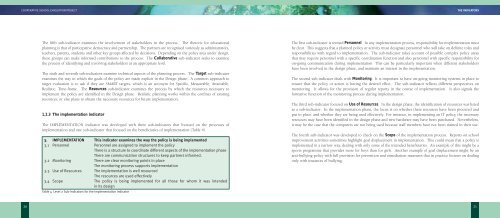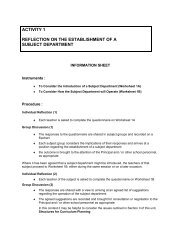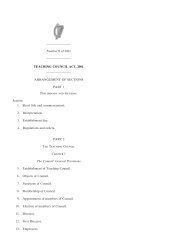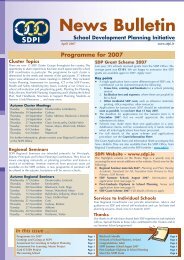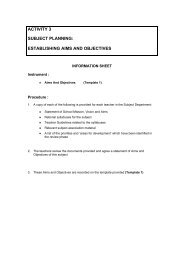Co-Operative School Evaluation Project (File Format PDF 550KB)
Co-Operative School Evaluation Project (File Format PDF 550KB)
Co-Operative School Evaluation Project (File Format PDF 550KB)
Create successful ePaper yourself
Turn your PDF publications into a flip-book with our unique Google optimized e-Paper software.
COOPERATIVE SCHOOL EVALUATION PROJECT<br />
THE INDICATORS<br />
The fifth sub-indicator examines the involvement of stakeholders in the process. The rhetoric for educational<br />
planning is that of participative democracy and partnership. The partners are recognised variously as administrators,<br />
teachers, parents, students and other key groups affected by decisions. Depending on the policy area under design,<br />
these groups can make informed contributions to the process. The <strong>Co</strong>llaborative sub-indicator seeks to examine<br />
the process of identifying and involving stakeholders at an appropriate level.<br />
The sixth and seventh sub-indicators examine technical aspects of the planning process. The Target sub-indicator<br />
examines the way in which the goals of the policy are made explicit in the Design phase. A common approach to<br />
target evaluation is to ask if they are SMART targets, which is an acronym for Specific, Measurable, Attainable,<br />
Realistic, Time-frame. The Resources sub-indicator examines the process by which the resources necessary to<br />
implement the policy are identified in the Design phase. Realistic planning works within the confines of existing<br />
resources, or else plans to obtain the necessary resources for future implementation.<br />
1.2.3 The implementation indicator<br />
The IMPLEMENTATION indicator was developed with three sub-indicators that focused on the processes of<br />
implementation and one sub-indicator that focused on the beneficiaries of implementation (Table 4).<br />
3. IMPLEMENTATION This indicator examines the way the policy is being implemented<br />
3.1 Personnel Personnel are assigned to implement the policy<br />
There is a structure to coordinate different aspects of the implementation phase<br />
There are communication structures to keep partners informed.<br />
3.2 Monitoring There are clear monitoring points in place<br />
The monitoring process supports implementation<br />
3.3 Use of Resources The implementation is well resourced<br />
The resources are used effectively<br />
3.4 Scope The policy is being implemented for all those for whom it was intended<br />
in its design<br />
Table 4 Level 2 Sub-Indicators for the Implementation Indicator<br />
The first sub-indicator is termed Personnel. In any implementation process, responsibility for implementation must<br />
be clear. This suggests that a planned policy or activity must designate personnel who will take on definite roles and<br />
responsibilities with regard to implementation. The sub-indicator takes account of possible complex policy areas<br />
that may require personnel with a specific coordination function and also personnel with specific responsibility for<br />
on-going communication during implementation This can be particularly important when different stakeholders<br />
have been involved in the design phase, and maintain an interest in the implementation.<br />
The second sub-indicator deals with Monitoring. It is important to have on-going monitoring systems in place to<br />
ensure that the policy or action is having the desired effect. The sub-indicator reflects different perspectives on<br />
monitoring. It allows for the provision of regular reports in the course of implementation. It also signals the<br />
formative function of the monitoring process during implementation.<br />
The third sub-indicator focused on Use of Resources. In the design phase, the identification of resources was listed<br />
as a sub-indicator. In the implementation phase, the focus is on whether these resources have been procured and<br />
put in place, and whether they are being used effectively. For instance, in implementing an IT policy, the necessary<br />
resources may have been identified in the design phase and new hardware may have been purchased. Nevertheless,<br />
it may be the case that the computers are not being used because staff members have not been trained in their use.<br />
The fourth sub-indicator was developed to check on the Scope of the implementation process. Reports on school<br />
improvement activities sometimes highlight goal displacement in implementation. This could mean that a policy is<br />
implemented in a narrow way, dealing with only some of the intended beneficiaries. An example of this might be a<br />
sports programme that provides more for boys than for girls. Another example of goal displacement might be an<br />
anti-bullying policy with full provision for prevention and remediation measures that in practice focuses on dealing<br />
only with instances of bullying.<br />
20<br />
21


